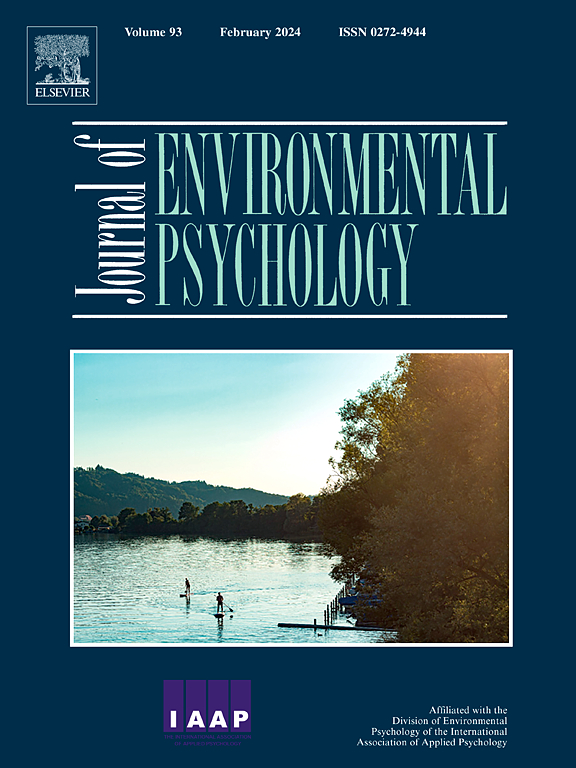Adapting and validating a game-based testing instrument for measuring nature connectedness in children
IF 6.1
1区 心理学
Q1 ENVIRONMENTAL STUDIES
引用次数: 0
Abstract
This study aimed to adapt and validate a Canadian-developed instrument for measuring nature connectedness among young children in China. Nature connectedness, which encompasses emotional, cognitive, and experiential relationships with the natural environment, is linked to various positive outcomes in children, including well-being, eco-friendly behaviors, and academic success. However, existing instruments, which often rely on self-reports, face challenges when applied to young children due to dependence on introspective and expressive abilities and issues with cultural relevance across diverse settings. To address these limitations, this research adapted and validated a game-based instrument through three steps: adaptation for cultural relevance and linguistic accuracy, expert review for content validity, and empirical testing for construct validity. The initial adaptation was informed by a pilot study with 38 children in Hangzhou, which led to further modifications based on feedback. The adapted Chinese version was tested with 406 kindergartners from Hangzhou and Shanghai, demonstrating good reliability and validity in measuring nature connectedness in this population. Findings indicate that the adapted instrument effectively captures the dimensions of nature connectedness among young Chinese children, validating its feasibility of adapting for use in non-Western contexts. This research underscores the importance of culturally sensitive tools in environmental psychology and education, offering a valuable methodology for understanding and enhancing children's connections with nature across different cultural backgrounds. The study contributes to developing educational strategies and environmental policies to foster a deep, enduring relationship between children and the natural world.
改编并验证基于游戏的测试工具,以测量儿童与自然的联系
本研究旨在调整和验证加拿大开发的用于测量中国幼儿自然联系的工具。自然联系包括与自然环境的情感、认知和体验关系,与儿童的各种积极结果有关,包括幸福感、环保行为和学业成功。然而,由于依赖于内省和表达能力,以及不同环境下的文化相关性问题,现有工具通常依赖于自我报告,在应用于幼儿时面临挑战。为了解决这些局限性,本研究通过三个步骤对基于游戏的工具进行了改编和验证:针对文化相关性和语言准确性的改编、针对内容有效性的专家审查以及针对构建有效性的实证测试。最初的改编参考了在杭州对 38 名儿童进行的试点研究,并根据反馈意见作了进一步修改。改编后的中文版本在来自杭州和上海的 406 名幼儿园儿童中进行了测试,结果表明在测量该人群的自然联系方面具有良好的信度和效度。研究结果表明,改编后的工具有效地捕捉到了中国幼儿自然联系的各个维度,验证了其在非西方环境中改编使用的可行性。这项研究强调了文化敏感工具在环境心理学和教育学中的重要性,为理解和加强不同文化背景下儿童与自然的联系提供了宝贵的方法。这项研究有助于制定教育战略和环境政策,促进儿童与自然世界之间深厚、持久的关系。
本文章由计算机程序翻译,如有差异,请以英文原文为准。
求助全文
约1分钟内获得全文
求助全文
来源期刊

Journal of Environmental Psychology
Multiple-
CiteScore
10.60
自引率
8.70%
发文量
140
审稿时长
62 days
期刊介绍:
The Journal of Environmental Psychology is the premier journal in the field, serving individuals in a wide range of disciplines who have an interest in the scientific study of the transactions and interrelationships between people and their surroundings (including built, social, natural and virtual environments, the use and abuse of nature and natural resources, and sustainability-related behavior). The journal publishes internationally contributed empirical studies and reviews of research on these topics that advance new insights. As an important forum for the field, the journal publishes some of the most influential papers in the discipline that reflect the scientific development of environmental psychology. Contributions on theoretical, methodological, and practical aspects of all human-environment interactions are welcome, along with innovative or interdisciplinary approaches that have a psychological emphasis. Research areas include: •Psychological and behavioral aspects of people and nature •Cognitive mapping, spatial cognition and wayfinding •Ecological consequences of human actions •Theories of place, place attachment, and place identity •Environmental risks and hazards: perception, behavior, and management •Perception and evaluation of buildings and natural landscapes •Effects of physical and natural settings on human cognition and health •Theories of proenvironmental behavior, norms, attitudes, and personality •Psychology of sustainability and climate change •Psychological aspects of resource management and crises •Social use of space: crowding, privacy, territoriality, personal space •Design of, and experiences related to, the physical aspects of workplaces, schools, residences, public buildings and public space
 求助内容:
求助内容: 应助结果提醒方式:
应助结果提醒方式:


